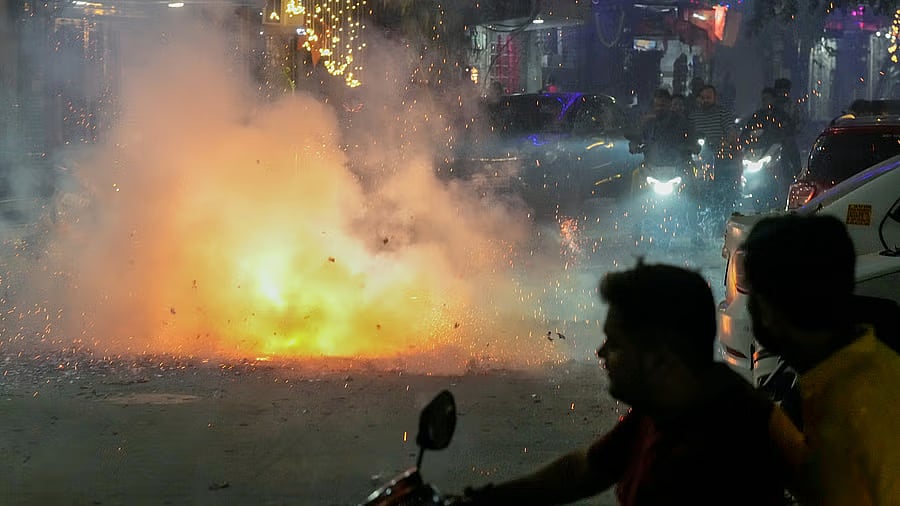
Representative image of firecrackers.
Credit: PTI File Photo
A huge explosion shattered the evening calm at the Dakshin Raipur village in the South 24 Parganas district of West Bengal on March 31. The blast killed four children, including two newborns, three women, and an elderly man of the same family, headed by Chandrakanta Banik and his brother Tushar Banik, who had not only been running a fireworks manufacturing unit but had also stored inflammable raw materials and crackers in the house.
A day later, another massive explosion reduced a warehouse at Deesa in Gujarat’s Banaskantha district into a heap of rubble. The warehouse was being used to run an illegal fireworks factory as well as for storing crackers. As many as 21 workers were killed. Less than a fortnight later, another blast at a similar factory in Anakapalle in Andhra Pradesh killed eight workers.
With fireworks manufacturing units – some legal, some illegal, but mostly with zero to nominal adherence to safety standards – mushrooming, such tragedies are being reported from across the country with an appalling regularity, not only from Sivakasi, the Tamil Nadu town, known as the “cracker capital of India”.
Rajesh Nayak was one of the workers who were brought in from Madhya Pradesh to work at the fireworks factory at Deesa in Gujarat. He had stepped out for a break when the blast ripped apart the factory on April 1, killing most of his co-workers. He told the Gujarat Police investigators that he had been earning Rs 300 or Rs 400 as daily wages.
The probe revealed that no fire safety measures had been put in place, and not even a single extinguisher had been provided, although a large quantity of crackers and raw materials had been stored in the warehouse. The workers, some with families, had been staying in makeshift tents just adjacent to the factory, filled with hazardous substances.
The investigation by the West Bengal police into the March 31 blast also revealed that Chandrakanta Banik had continued to run the factory at his home in blatant disregard of the safety of his own family and his neighbours, although his application for renewal of the licence had been turned down in 2023. He was arrested after the blast.
Supratim Sarkar, Additional Director General of Police (South Bengal), said that the West Bengal Police would convene a meeting of the firecracker manufacturers to stress the need to strictly adhere to the safety norms. After a series of such deadly accidents in illegal fireworks factories in West Bengal, the state government had, in May 2023, set up a committee to look into the issue.
The probe into the April 13 blast at the factory in Andhra Pradesh found that the unit had exceeded the authorised limit of storing 15 kg of raw materials. The investigation into the October 2023 blast at the manufacturing unit in Attibele in Bengaluru Rural had also revealed that the unit had stored a large amount of unauthorised ingredients.
Most of the mishaps at fireworks factories are reported from Sivakasi in Tamil Nadu, a large number of them caused by blatant disregard for the safety regulations.
The firecracker factories are governed by the Explosives Act of 1884 and the Explosives Rules of 2008. The Petroleum and Explosives Safety Organisation (PESO) has just 106 officers, against the sanctioned strength of 137, to monitor adherence to safety standards at 3.7 lakh hazardous units, including the licensed fireworks factories.
Rajesh also had a providential escape in February 2024, when a blast at a cracker factory at Harda in Madhya Pradesh killed 13 of his co-workers. He saw how disregard for safety norms could lead to mishaps. The pursuit of a livelihood, however, still forced him to brush aside the safety concerns and take the job at the factory in Gujarat. As the demand for firecrackers remained unabated despite environmental concerns, he will possibly find another job elsewhere sooner or later. But will his luck still favour him when the next disaster strikes?
India is reported to be the second-largest manufacturer of firecrackers in the world after China. And, the industry is said to be growing faster, as fireworks have become central to all kinds of celebrations, no longer limited to just Diwali. Right from weddings to Team India’s victory, bursting firecrackers to express happiness has only been increasing, notwithstanding concerns over environmental implications.
But, to make the fleeting spectacle of firecrackers possible, thousands of faceless workers covered in silver gunpowder work relentlessly for wages as low as Rs 300 a day. The workers, largely from the marginalised communities such as Other Backward Classes, Denotified Tribes (Devipujaks), and Dalits, are always at the risk of losing their lives or limbs in blasts due to the lack of safety measures.
According to estimates, 90% of the production of firecrackers takes place in Sivakasi in Tamil Nadu, which also contributes the highest number of accidents and casualties as the industry remains highly unregulated and unorganised.
“In my experience, in most cases, you will see the units don't even have simple fire extinguishers," said a fire official in Ahmedabad who requested not to be quoted.
He added that in villages, like Vanch (known as Sivakasi of Gujarat), on the outskirts of Ahmedabad, the labourers work in the most hazardous conditions. They are covered in silver gunpowder from head to toe, with barely any safety measures installed in the premises. This is happening right under the authorities' watch.